
Single Trunk vs. Fused Trunks
Continued from: Largest Coast Redwoods
Copyright 2015 - 2017 by Mario Vaden

advertisement
This page stems from online discussions where people posted about largest coast redwoods and whether those were multiple stems fused centuries ago or whether they remained single trunks throughout the organism's life. A few among the most-discussed redwoods were Lost Monarch - Del Norte Titan - Melkor and Howland Hill Giant. Recently, Grogan's Fault entered the conversation because it has what seems like an indentation on one side, or what some nickname "fusion lines". A few people look for lines to categorize redwoods into group A single trunks or group B fused trunks. Regarding Grogan's Fault, I will pick up the conversation after a few images.
It became evident that pieces were missing from the conversation and several people expressing ideas had limited experience compared to others long-employed in the arboriculture profession. In addition to experience, dissecting offers a big advantage for learning. Pruning work also helps to expose interior wood for more understanding. Related, storm damage and other removals are opportunities to cut trunks apart and observe characteristics and development. One of the best at this was Dr. Alex Shigo who used to be the head scientist of the US Forest Service. Sometimes called the Father of modern Arboriculture.
After 2016, I plan to look more carefully at many of the titan redwoods again. Right now, my candidate choices for single stem coast redwoods lean in favor of Atlas redwood, Spartacus and Bell to name a few. And the fused or merged include Sir Isaac, Drury, Howland Hill Giant and Melkor to name several.
I added images below and will comment following each one.
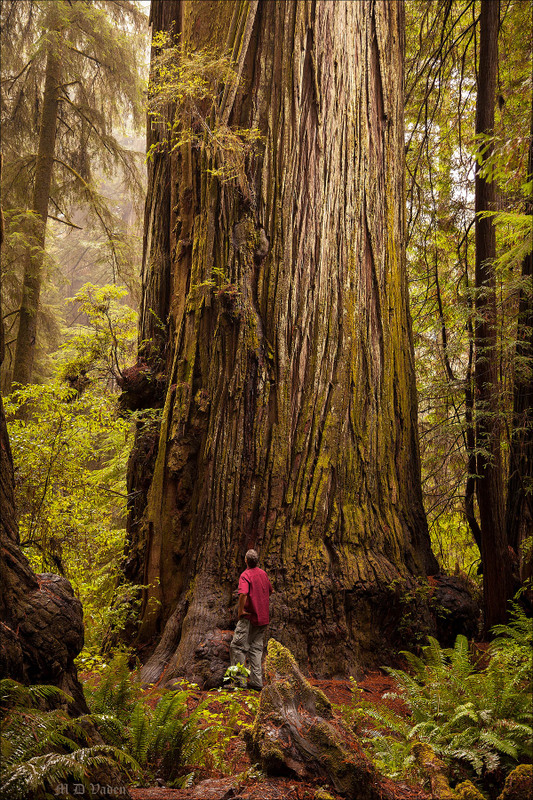
The Coast Redwood above is Howland Hill Giant in Jedediah Smith Redwoods State Park. Quite a few people consider it to be a single trunk redwood, not fused.
In 2015 I took a closer look at Howland Hill Giant and began to find signs of multi-stem origin. January 2017 I returned one morning during optimum lighting and found it's tell-tale "fingerprints" of fused or merged stems on several sides. It's page was updated. Certainty 100%. It's also more elliptical than I thought. The time it took to reach this conclusion reminds me of the Tsunami hemlock discovery. The foliage was so high up on an overcast day, it was hard to ascertain the species. But given more time, details were found that answered the question. In this case, species wasn't the question. Prior to 2015, I didn't really pay close attention in regard to single of fused stems because so many people just accepted single stem as gospel. But in 2015 something caught my attention and the redwood unveiled it's past.
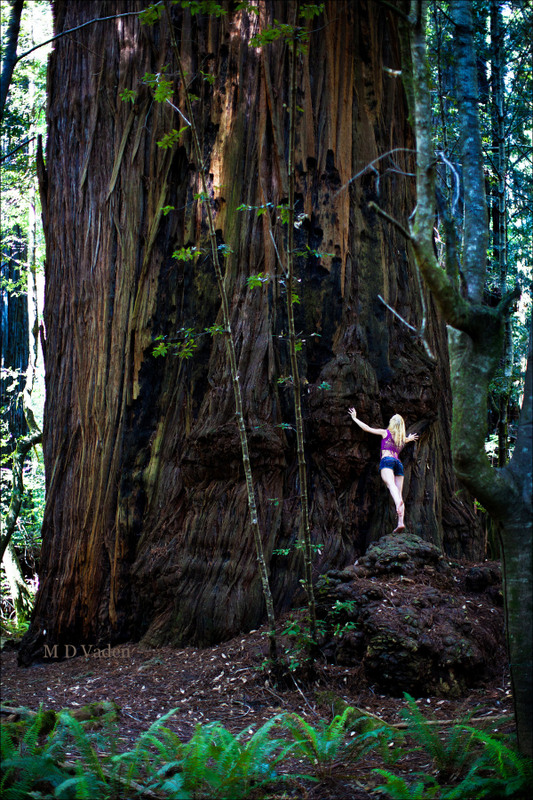
The redwood above is called Melkor .. aka Fusion Giant ... in Redwood National Park. Among the largest, this too must be a fused trunk redwood where a large percentage of the trunk is due to an entra stem.
Not only because it's elliptical but also because the trunk's character differs on both sides of the mostly vertical lines which are an additional sign of fusion or merging. It definitely has more than one stem up overhead, but I believe the lower trunk near ground level is two or three large stems that grew together.

advertisement
That said, I am not 1500 years old, so I can't prove it. On the other hand, I've worked with evergreens pruning them for more than 30 years; tens of thousands. And I know the language their characteristics speak.
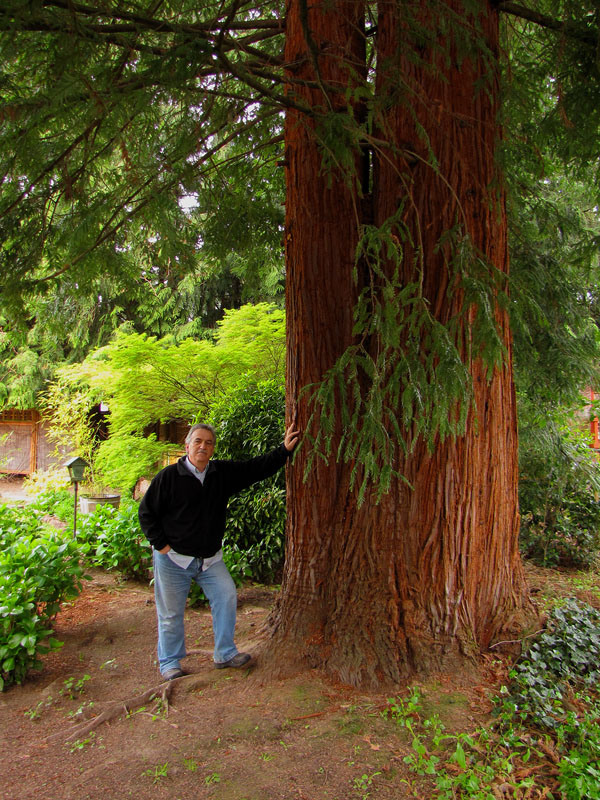
The redwood above is about 60 years old, planted in a large residential landscape. Its characteristics included root suckers among the ground cover and its evident this is a multi-stem trunk that will probably become what we could call "fused" looking as it ages.
The reason I added that image is because the base is more or less round. Here we see a redwood that will most likely grow a fused trunk and continue a round "footprint" on the ground.
Fusion annd elliptical do not have to go hand-in-hand.
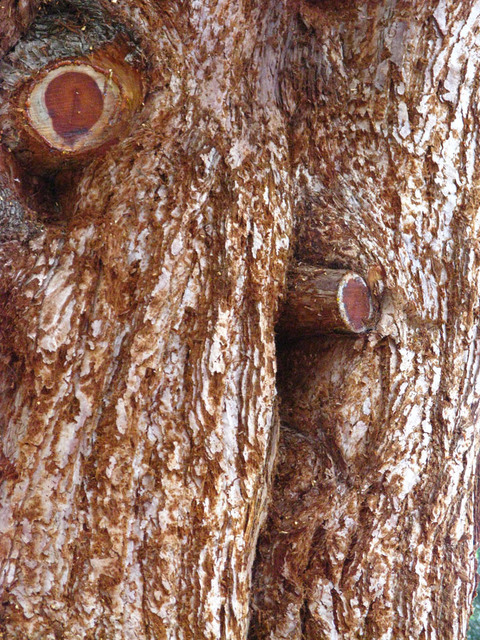
The redwood above is Giant Sequoia / Sequoiadendron giganteum. It developed vertical lines or cleavage with no related trunk damage. Thats just the way some of them grow. The vertical lines can mean next to nothing in regards to fusion of stems.
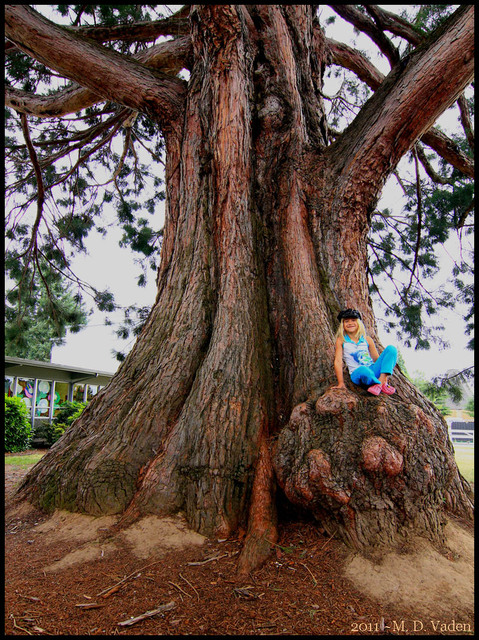
Another Giant Sequoia to establish one point. All that vertical cleavage is just one redwood trunk growing on flat level ground. This was is in Roseburg north of Grants Pass.
That image lays groundwork for comments on the one below. Keep in mind that even with all that irregularity at ground level, we are looking at a single trunk with no fused stems.
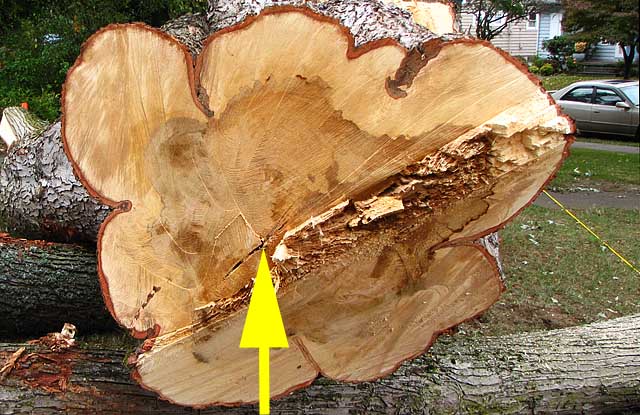
The one above is a maple with health problems, that needed removal. I tossed this image in the mix for two reasons. First, it is a single trunk and it's growth was headed more elliptical than round. Not a lot, but enough to see. Second, the pith or point of origin marked by the yellow arrow is not in the center of the trunk.
Don't let anybody feed you Bull that the center of a trunk is where the pith is located. Not unless they can prove it.
In the trunk above there is slightly more than 66% of the trunk's diameter on one side of it.
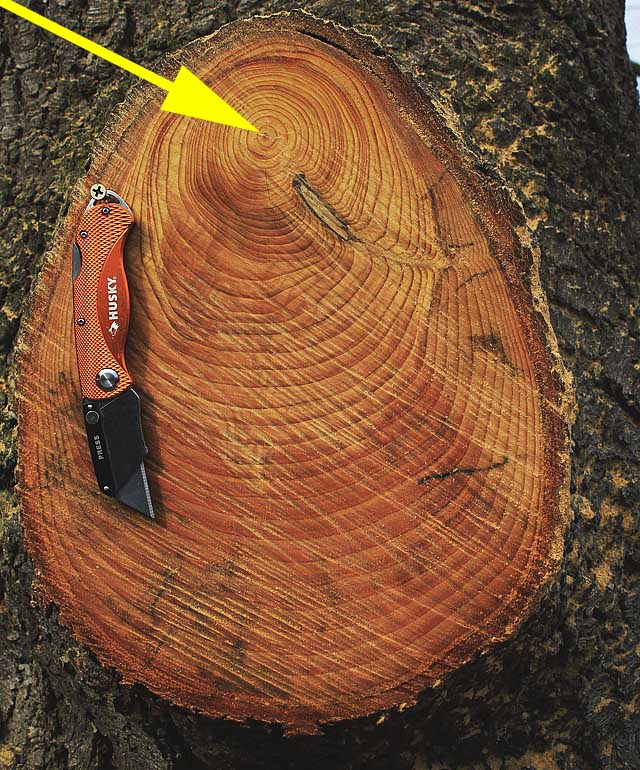
The example above is not a trunk but a substantial reiterated stem on the side of a Deodar Cedar removed under utility lines. The pith or center is marked by the yellow arrow.
Over 84% of it's diameter is on one side of the pith.
The previous maple and Deodar cedar images show how far off-center the middle of trunks can vary. These examples virtually slay and destroy claims the original pith should be near the center of a trunk.
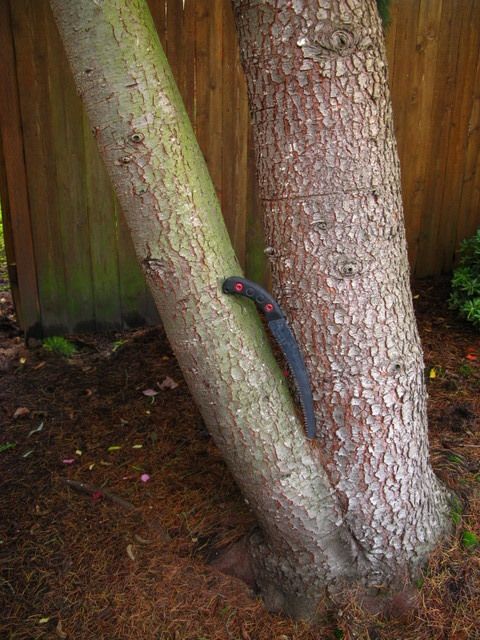
Now we return to the Grogan's Fault line discussion.
The Image above is a Deodar Cedar with an extra trunk. It is susceptible to the kind of damage shown in the image below.
When Grogan's Fault was discussed there were comments posted about "lines" indicative of fusion and "burls". Actually it has shapely growth on one side that is not burl wood. Part resembles a broken branch. The overall look appears to have be a version of this type of stem attachment but on Grogan's Fault proportionately small in relation to the main trunk. Then ... grown- over through the years with varying thickness and shapes of wood and bark.
I do not know for a fact - but if Grogan's Fault lost an extra small stem from the lower trunk and the stem was tight against the main trunk overhead, that should leave an indentation resulting in a vertical line.
There are several ways trunks can get vertical lines.
1. Extra stem fit tight against another, possibly embedding. 2. Lightning strike top to bottom. 3. Stem or branch breaks, peeling large strips of bark and cambium downward. 4. Sunburn killing tissue up and down a strip on one side.
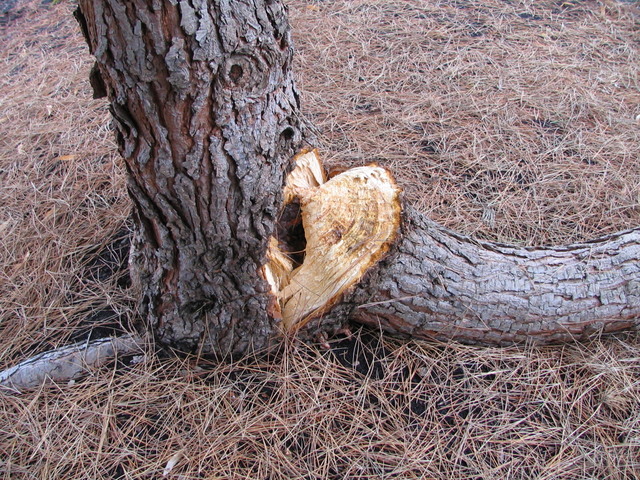
This damage can happen to almost any species with an extra stem similarly attached. On a much larger scale in the coast redwood forest this is what opens the door for goosepens or caves in trunks. One of the multiple trunks peel away and fall due to weight or wind, leaving bare wood that forest fires can burn-away after years or centuries.
Regarding Grogan's Fault, I can't confirm if the line on the trunk was caused by an extra stem. But ... the shape and appearance of the trunk confirms for me that there was an extra stem on the lower trunk. It still has a couple of extra stems remaining. I believe one broke off. Must have been a long time ago. Nothing remains on the ground. The only thing indicative are the shapes of the bark and trunk on one side.
This is probably the cause of the "eye" on what seems like an imaginary face on the Drury giant redwood, leaving a sort of eye socket. But the breakage was up from the ground a short way.
It is like a language that takes decades to learn. Not quite like a wind talker thing. But after decades working with this, there is a message that can be received from the trunk, branches, leaves and roots. Books and classes won't teach this. It takes a lot of years and a lot of wood.
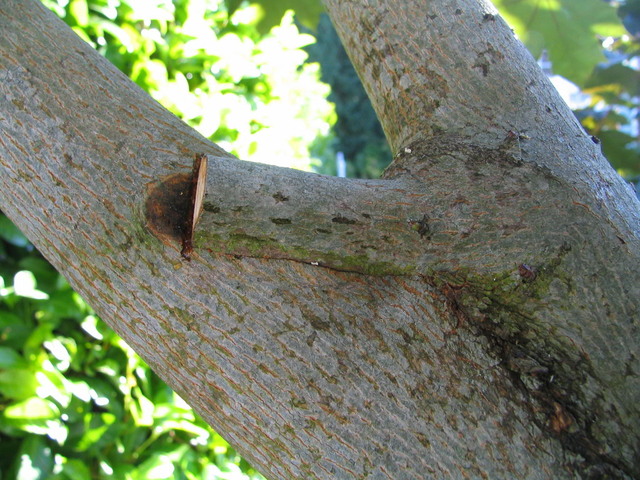
Wood is not very flexible. In the same way this branch embedded into the adjacent trunk, extra trunks can also embed into others.
They may self-graft or fuse, or they may not. But if they break away it leaves an indentation or mark. In the case of a vertical stem after the remaining trunk grows more tissue it can leave what seems like a "line". The wider the diameter of the remaining trunk, the more the indentation will seem like a line.
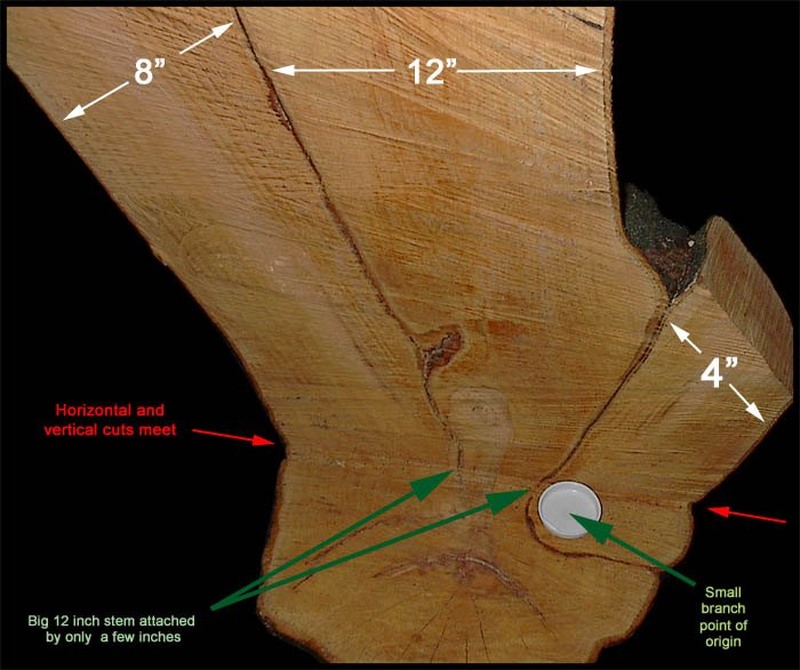
This is a piece cut from Flowering plum. One that disintegrated from more weakness overhead similar to what is revealed in the image. The trunk above was single and solid for the first few feet. Near shoulder height it branched into this weak mess of multi codominant stems and the tight-fitting branch embedded on the right side (lens cap area).
This is a repeat to show how stems leave indentations and also included bark. If you do not know what included bark is, search, there are many references. In short, bark gets wedged-in at narrow unions and between trunks growing in close proximity.
Often the trunks do not self-graft or bond. The bark on either side is not attached or bonded like wood. It is weak and more vulnerable to splitting.
Good chance on Melkor, and almost certainly behind Lost Monarch's largest basal stem ... there is a layer of included bark like this concealed between it and the main trunk.
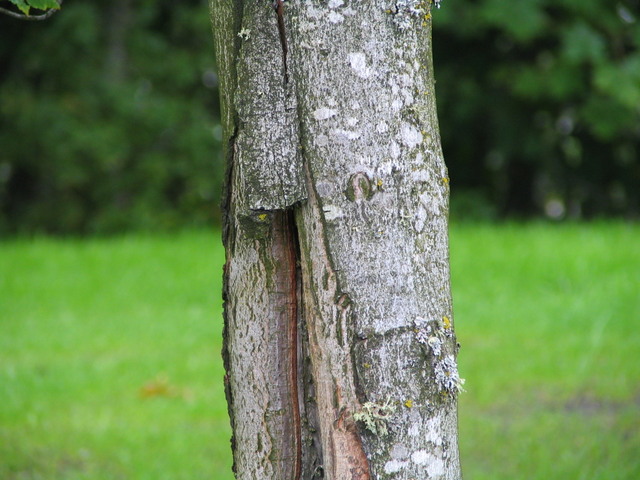
Sunburn damage.
One more thing that can cause tissue damage that can leave "lines" on a trunk after some years of extra tissue growth. This should not be common in the coast redwood forest. but possible in some places.
Inland, this is about the most common cause of damage I see to trunks and branches.
Read my page on sunburn for more.
You may find a video I put on Youtube too.
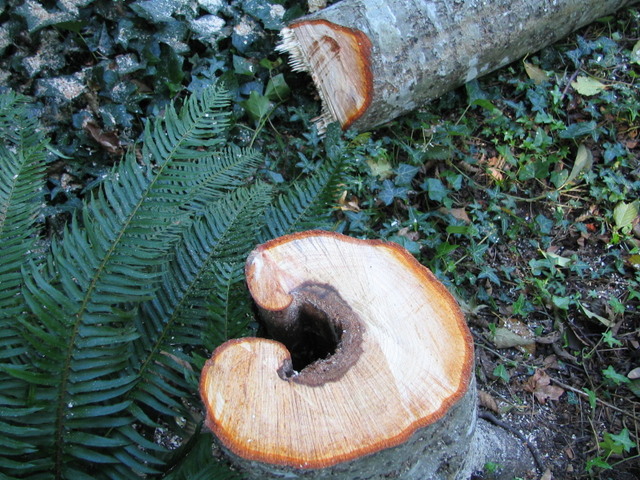
The image above is similar to the previous. Sunburn damage. The wound began at the inner part of the "curl" ... and its evident how new growth occurs, and narrows the gap each year. Given time, is will form a cleavage, slit and line.
Again ... relate this all back to "lines" on redwoods.
That's the reason to share all this, to show that "lines" in themselves do not ascertain fusion.
The same appearance in this image can result from some lightning strikes or branches breaking and peeling bark down along a trunk.
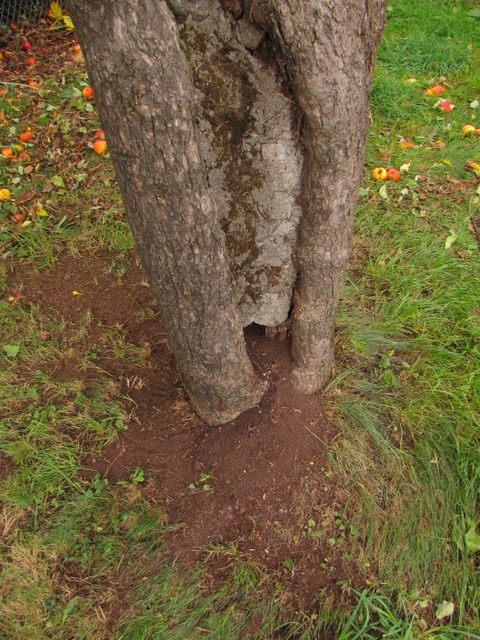
Above ... is NOT sunburn.
That was from a large scaffold limb breaking and peeling bark and cambium down off the trunk. And given time, like some sunburn damage, this can leave "lines" up or down trunks.
How do you tell whether it was sunburn or tearing?
That's where experience teaches the language that answers the question.
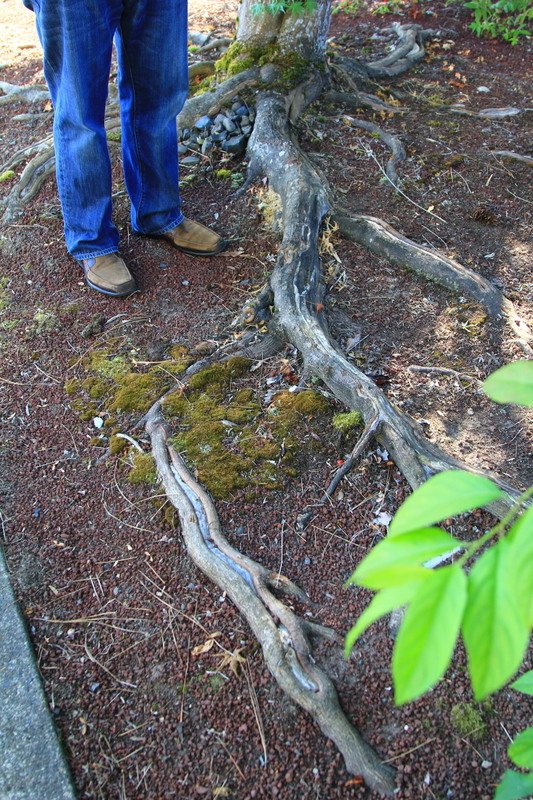
Roots
Had to throw this one in. It won't relate to single or fused trunks much. But since I covered sunburn, it seemed worth interjecting. The damage is not from walking or tires. The dead tissue is from sunburn.
This is a Japanese maple which had too much cut from the top ... probably late May to September. That allowed sunlight to penetrate thin bark and destroy the cambium layer. This was a butcher hack job. But I've seen this occur when proper cuts were made.
Many people will see something like this and immediately assume it was caused by walking, driving, etc., when it was actually caused by something completely different.
Now back to "lines" on trunks
Some people will see lines on trunks and assume it means one thing, when it may be something entirely different.
Hopefully this helps a few readers broaden how they form their opinion

advertisement